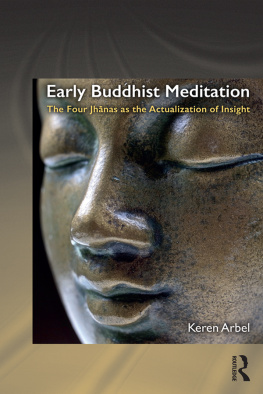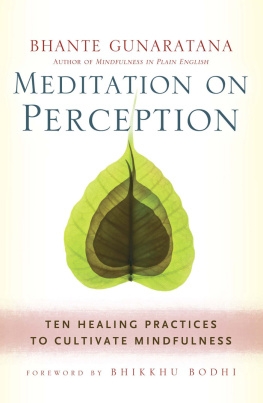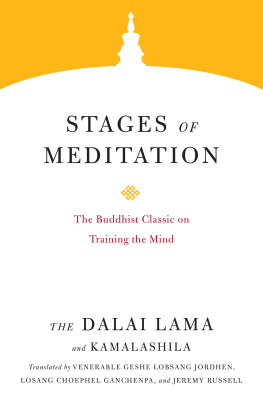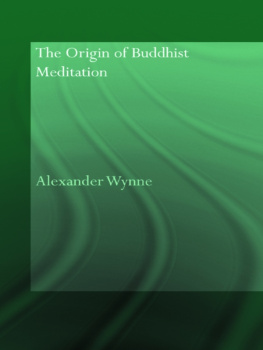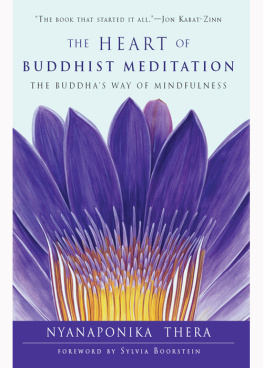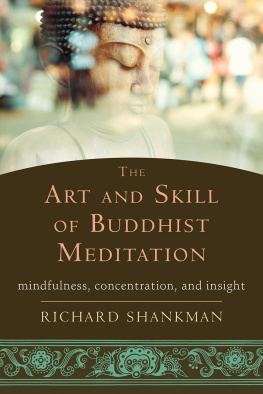While numerous works on Buddhist meditation are available today, there is still a need for an accessible and understandable handbook. The book you are holding is precisely such an exhaustive work. By presenting some of the basic methods, it offers us a detailed map with clear instructions about the path leading to tranquillity and insight. This book is the fruit of the authors many years experience of meditation and teaching, with a wealth of advice for those who are taking their first steps on the path, as well as more experienced practitioners.
arko Andr i evi , founder of Dhammaloka, Zagreb, Croatia.
This enhanced new edition guides readers more clearly into the meditations and draws out their significance more fully, now explicitly oriented around the system of meditation. This system provides a fine framework both for understanding where various practices fit in and for reflecting on the nature of our own spiritual experiences. Kamalashila has also woven in an appreciation of a view of the nature of mind that in the Western tradition is known as the imagination, helping make an accessible link to our own philosophical and cultural traditions.
Lama Surya Das , author of Awakening the Buddha Within , founder of Dzogchen Center and Dzogchen Meditation Retreats, USA.
A wonderfully practical and accessible introduction to the important forms of Buddhist meditation. From his years of meditation practice, Kamalashila has written a book useful for both beginners and longtime practitioners.
Gil Fronsdal , author of A Monastery Within , founder of the Insight Meditation Center, California, USA.
His approach is a clear, thorough, honest, and, above all, open-ended exploration of the practical problems for those new and even quite experienced in meditation.
Lama Shenpen Hookham , author of There is More to Dying Than Death , founder of the Awakened Heart Sangha, UK.
Buddhist Meditation
Tranquillity, Imagination and Insight
Kamalashila

Published by
Windhorse Publications
169 Mill Road
Cambridge
CB1 3AN
UK
info@windhorsepublications.com
www.windhorsepublications.com
Kamalashila, 1992, 2012
First edition 1992
Second edition 1996, reprinted 1999, 2003
This edition 2012
The right of Kamalashila to be identified as the author of this work has been asserted by him in accordance with the Copyright, Designs and Patents Act 1988.
Typeset and designed by Ben Cracknell Studios
Photographs Alokavira/Timm Sonnenschein
Cover design by Dhammarati
Cover image: photograph of cat. 27c Head of a Buddha, Northern Qi dynasty (550557), from Qingzhou Municipal Museum, China, from p. 61 of Return of the Buddha , Royal Academy of Arts, London, 2002.
Despite numerous communications with The State Administration of Cultural Heritage, The Peoples Republic of China, the copyright holder of this image could not be located.
British Library Cataloguing in Publication Data:
A catalogue record for this book is available from the British Library.
ISBN: 9781-907314-09-4
epub ISBN: 978-1-907314-45-2
Kindle ISBN: 978-1-907314-42-1
A Windhorse Publications ebook
Windhorse Publications would be pleased to hear about your reading experiences with this ebook at info@windhorsepublications.com
References to Internet web sites (URLs) were accurate at the time of writing. Neither the author nor Windhorse Publications is responsible for URLs that may have expired or changed since the manuscript was prepared.
Contents
List of tables
Integration and positive emotion
The system of meditation
Stages of the mindfulness of breathing meditation
Stages of the Mett Bhvan meditation
Conditions for effective meditation
Sequential characteristics of ordinary consciousness,
access concentration and the first dhyna
The spectrum of dhyna factors
Moving from the hindrances to the dhyna factors
Progress of the dhyna factors through the first four dhynas
Progressive changes in experienced meditation object
The three planes of conditioned existence
The five conditioning natures
The five basic methods of meditation
Stages of Karu Bhvan meditation
Stages of Mudit Bhvan meditation
Stages of Upekkh Bhvan meditation
Stages of bodhicitta meditation
Stages of the six-element practice
Stages of stpa visualization
Stages of contemplation of the twenty-four nidnas
Sinking and drifting
Aspects of sinking
Aspects of drifting
List of figures
The stpa
Full lotus
Hand position (dhyna mudr)
Full lotus, side view
Half lotus
One foot on calf
One leg in front
Kneeling with cushions
Kneeling on a stool
Sitting on a chair
Sitting with back against a wall
Overarching backwards
Slumping forwards
Direction of spine, chest, shoulders, and arms
Position of head
Soft floor covering to protect knees and ankles
Padding supporting raised knee
Padding supporting hands and knee
Blanket for warmth
Preface to the third edition
This is a completely rewritten edition of the original Meditation: The Buddhist Way of Tranquillity and Insight , published in 1992.
When I started the project in the mid-1980s, meditation and Buddhism were hardly known about in the general population, and certainly not widely practised as they are today. A comprehensive manual of Buddhist meditation practice from a Western teacher was virtually unique. My basic material, a seminar on Zhiyis (Chi-Is) Dhyna for Beginners given by Sangharakshita in 1975, contained plenty of practical, traditional teachings about the way to develop both the dhynas and insight in Buddhist meditation. This was a good, reliable source, to which I added my fledgling teaching experience, but for comparative Dharma texts I could choose only from the few available in those days, such as The Songs of Milarepa and Suzuki Rshis Zen Mind, Beginners Mind . As for other meditation manuals, I found virtually nothing: I used a scholarly survey of the Visuddhimagga by Vajiraa Mahthera and a somewhat impenetrable work by Yogi Chen, who had been one of my own teachers teachers. Both texts were entitled Buddhist Meditation.
The book was well received, and has sold steadily and modestly since its publication. But so much has changed since 1992. Everyone knows about meditation, Buddhism is a standard subject in schools, at least in the UK, and mindfulness has become an important form of therapy. Meditation is well taught by many Western teachers in numerous traditions, and there is an abundance of good written advice on meditation if you know where to look. So the challenge, when Windhorse Publications broached the possibility of a rewrite, was whether this well-aged book could add to or enhance any of that.
The original material on the principles of meditation practice and much of the practical advice about supporting a deeper application of meditation still seem relevant and valuable. But I have long felt I could produce a better book by improving the writing and drawing on developments in my own practice over the past twenty years an idea initially planted in my mind by Jonathan Shaw in 2000. I hope the new edition guides readers more clearly into the meditations and draws out their significance more fully.
The main change is that the whole book is now explicitly orientated towards the system of meditation devised by Sangharakshita in the 1970s. This brings out how the practices I have described fit together as part of an integrated path to Awakening. I have also woven in an appreciation of a view of the nature of mind that in Western tradition is known as the imagination, as it makes an accessible link to our own philosophical and cultural traditions. Imagination is not just another way of viewing our mental and emotional reality, it is also helpful as a connection with meditation because we are familiar with it from our own arts and literature; it speaks in a more poetic voice than the technical language of the Pali texts.





